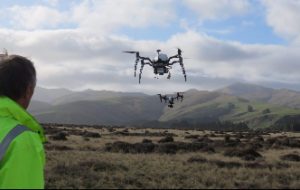 Researchers in New Zealand are hoping a drone test range will open up new horizons for the nation’s growing UAV industry.
Researchers in New Zealand are hoping a drone test range will open up new horizons for the nation’s growing UAV industry.
At the University of Canterbury’s Spatial Engineering Research Centre, a partnership of academic and commercial players recently launched a specialized test range. Officials see the complex as a way to promote the growth of drone-industry niche sectors including structural inspections, precision agriculture and marine biology surveys.
Last year, New Zealand’s Civil Aviation Authority granted 38 square miles of airspace to the Centre and gave permission for “segregated” testing to begin in July.
“Drones have moved from a toy to an industry tool and are becoming much more capable of flying themselves. To regulate this, we have been working with the CAA to develop new rules for operating drones, which came into effect in August 2015,” SERC senior research engineer Kelvin Barnsdale said in a university news release.
“One of the enduring limitations of the new rules requires drones to be used within line of sight of the pilot. The CAA doesn’t call these unmanned aerial vehicles – they treat them as remotely piloted, which is a significant difference. So to test new airborne technology that goes beyond line of sight, we needed a segregated test range,” he added.
University officials explain that SERC’s test range comprises restricted airspace that, when activated, legally excludes any other aircraft in that area. Researchers will be able to fly drones above the regulation 400 feet and beyond line of sight under special conditions.
Barnsdale says the line-of-sight exemption will attract industry R&D agreements from the U.S., Europe and Australia.
“We are also currently using the test range for instrument trials, working towards the use of drones for high altitude atmospheric research over the Southern Ocean and Antarctica,” said Aeronavics Technology Development Manager Edwin Hayes. His company is partnering with the university to maximize the test range’s capabilities.
New Zealand has led the charge to embrace drone technology over the past few years. Several public-safety agencies are queuing up to add UAVs to their bundle of resources.
In April, the New Zealand National Fire Service announced a plan to deploy 17 drones which would be hauled to various hotpots via special “haz-mat” trucks. In February, New Zealand’s military police force announced it would eventually replace aging aircraft with drones to support police border patrols. The New Zealand Defence Force’s police arm currently has six P-3K2 Orion aircraft scheduled to be retired over the next decade.
 Unmanned Aerial Vehicle The latest drone news
Unmanned Aerial Vehicle The latest drone news



